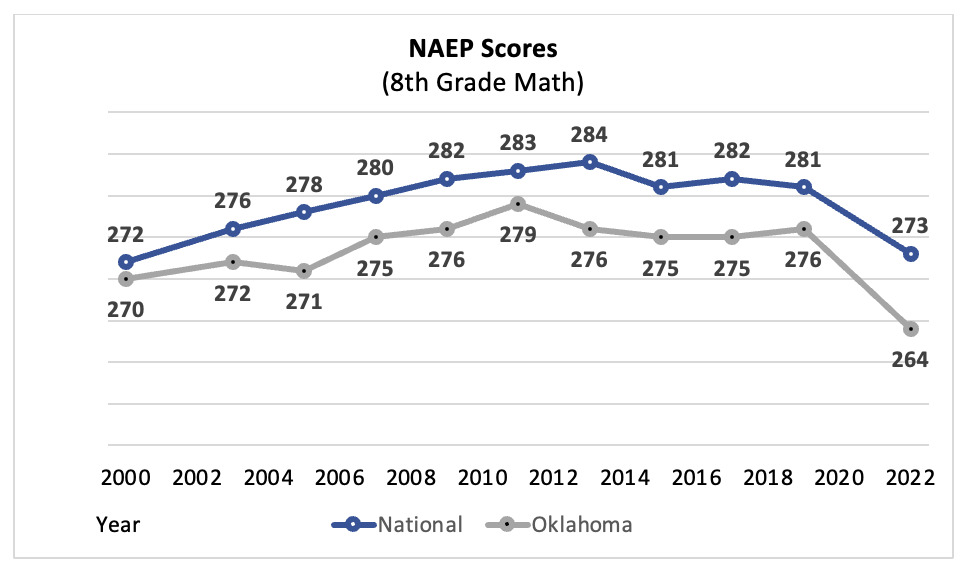In fall of 2022, the U.S. Department of Education released results from its National Assessment of Educational Progress (NAEP) – the so-called Nation’s Report Card. The results were sobering. Scores in reading and math dropped substantially from 2019. Few were immune to the downward slide. Every state, including Oklahoma, showed a decrease in reading and math scores. High and low performing students alike experienced declines. All told, nearly two decades of growth on the NAEP vanished in 2022 (see chart).
Although many factors contribute to low student test scores, unprecedented disruptions to learning caused by the COVID-19 pandemic were almost certainly a major influence. Many in Oklahoma’s education community are looking to move forward, but there are competing ideas about how to do that. Some school leaders have called for new investments in high-dosage tutoring, summer learning programs, and intensive instructional interventions. Others are recommending new SEL programs that address pressing social and emotional needs of students. Governor Kevin Stitt has stated that teacher compensation, school choice, and career and technical education are going to be among his administration’s priorities during his second term (watch my policy discussion with the Governor here).
Different visions for how to improve education in the state will continue to be debated, but the shared belief that action should be taken suggests a commitment to education that is encouraging. It is thus with optimism about the future of education in our state that I welcome you to the first issue of the Oklahoma Education Journal. This new journal is dedicated to presenting relevant research and timely policy perspectives in accessible formats for an Oklahoma-based readership.
In this first issue, our team presents longitudinal research on the academic outcomes of virtual charter school students. NWEA’s Senior Research Scientist Megan Kuhfeld provides a review of research on summer learning programs while hope scholar Christopher Freeze examines efforts to make hope-centered practices a core part of Union Public School’s curricula and culture. Also in this issue, our contributors tackle key policy issues. University of Oklahoma professor David Blatt analyzes new legislation that could enable teachers to earn six-figure salaries. In our Point-Counterpoint feature, Erika Wright, President of the Rural School Coalition, and Oklahoma State University professor Jentre Olsen debate rural district consolidation in Oklahoma. University of Oklahoma professor Curt Adams also provides an authoritative review of How we learn: The new science of education and the brain.
Journal Content
The Oklahoma Education Journal highlights research based in Oklahoma in its Relevant Evidence features and offers neutral syntheses of national research on education issues affecting Oklahoma’s schools in Research Review articles. In each issue, we profile leaders in the state by exploring innovative programs unfolding in our state’s schools. In Point-Counterpoint features, contributors present well-reasoned arguments on opposing sides of a policy debate. Journal contributors also produce legal analyses, book reviews, school health and wellness features, and updates on state education news, events, and resources.
Our Commitment to Readers
The Oklahoma Education Journal spans the boundaries of research, policy, and practice. The editorial team is unwavering in its commitment to presenting accurate information to the greatest extent possible. We aim for neutrality and balance. The journal does not advocate for any political groups, ideologies, or programs. These promises to the readership guide the work of the editorial team and staff.
Author Bio
Daniel Hamlin is Professor of Education Policy and Research Director of the Leadership and Policy Center for Thriving Schools and Communities (THRIVE) at the University of Oklahoma.




